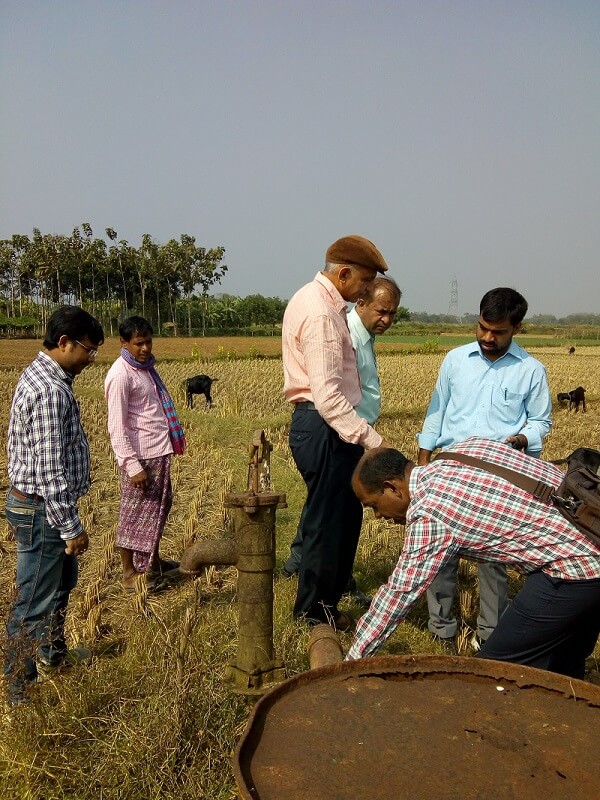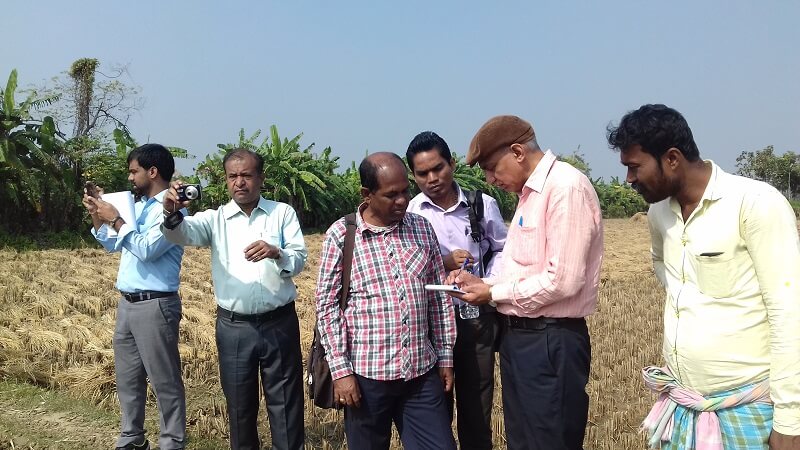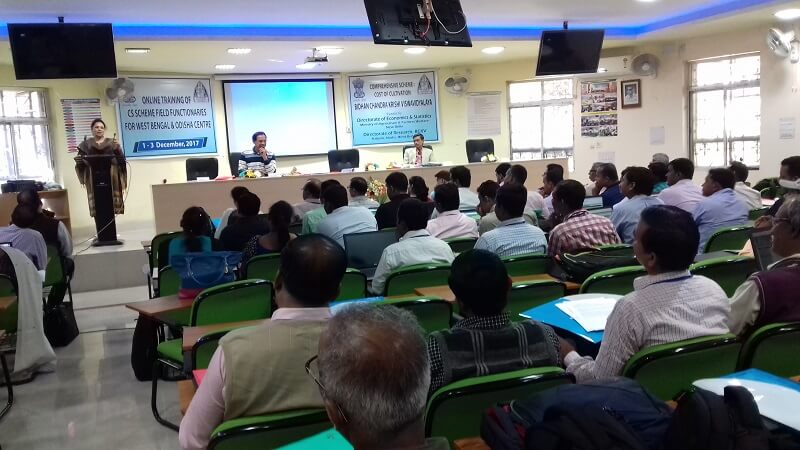Cost of Cultivation Project
Directorate of Economics & Statistics (DES),Government of India(GOI) initiated a scheme known as “Farm Management Studies (FMS)” in the year 1954-55 for collection of data on cost of cultivation & cost of production required for planning & policy formulation.
Because of the fact that the geographical coverage of FMS was limited, the Agricultural Prices Commission was not getting required data for the purpose it was constituted. In order to overcome such limitations, the GOI launched the “Comprehensive Scheme for Studying the Cost of Cultivation of Principal Crops in India” in the year 1970-71 on the basis of the recommendations of the “Standing Technical Committee on Indices of Input Costs” under Chairmanship of Dr. Ashok Mitra. Thus the scheme has a paramount National importance. DES plays the role of “Nodal Agency” for getting the survey conducted in 19 major States through 16 agricultural/general universities /college.
The data base generated through the scheme is not only used for the purpose of determining MSPs but also for other important purposes, namely, compilation of National Accounts Statistics, computation of wholesale price indices& research studies on cost of cultivation& farm income.
For qualitative improvement of the scheme, the GOI appointed “Special Expert Committee under the Chairmanship of Dr. S. R. Sen” to review the related issues pertaining to estimates of cost of cultivation. On the basis of the recommendations made by the “Special Expert Committee”, the GOI introduced modified “Comprehensive Scheme for Studying the Cost of Cultivation of Principal Crops in India” in the year 1981-82 with the introduction of “Crop Complex” study instead of a single crop approach.
However, the need for improvement & refinement never stops as agriculture never remains static. Subsequently, for further improvement & refinement, the Central Government appointed Expert Committees headed by eminent personalities like Prof. C.H Hanumantha Rao & Prof. Y.K Alagh.
With the beginning of crop year 2016-17, the DES, GOI has introduced “FARMAP-II” software replacing the “FARMAP” software developed by FAO in the year 1992.The Employees attached to the Scheme are mostly equipped with the new technology, i.e, on-line entry of data.
Vision & Mission:
The main objectives of the Scheme is to collect & compile field data annually on cost of cultivation & cost of production in respect of various agricultural crops & to generate crop-wise & state-wise estimate of cost of cultivation & cost of production of selected agricultural crops. These estimates are being finally utilized by the “Commission for Agricultural Costs & Prices (CACP)” to recommend the Minimum Support prices (MSPs) to the Central Government.
Objective
The objective of this scheme is to collect daily information from the selected farmers of sixty villages throughout West Bengal and assembled these for the Directorate of Economics & Statistics, Department of Agriculture & Cooperation, Ministry of Agriculture & Farmers Welfare, Government of India, for the cost of Cultivation of some major crops.
Procedure Adopted for Selection of Sample Cluster/Holding
West Bengal consists of six Agro-climatic sub region (Zones). The State is divided into 20 district, 342 Block/Tehsil, 3347 Gram Panchyayates and 40218 Villages. The State has 5238386 ha of Net cropped area. Paddy is the predominant crop of the State. Due to varies in agro-climatic zone different crops are grown in the state.
Zone-wise District of West Bengal
| Zone | District |
|---|---|
| I- Hill | Hill region of Darjeeling |
| II- Terai | Coochbehar, Jalpaiguri and Uttar Dinajpur (Partial), Siliguri Sub-division of Darjeeling District |
| III- New Alluvial | Uttar Dinajpur (Partial), Malda, Murshidabad, Nadia, North 24-Pargana (Partial) and Howrah (Partial) |
| IV- Old Alluvial | Dakhin Dinajpur, Murshidabad, Birbhum, Burdwan, Hooghly, Midnapur (W) (Partial) and Midnapur (E) (Partial) |
| V- Red & Latterite | Dakhin Dinajpur, Bankura, Purulia and Midnapur (W) (Partial) |
| VI- Coastal saline | South 24-Pargana, North 24-Pargana, Midnapur (E) and Howrah(Partial) |
New Crop Complex:
The Directorate of Economics & Statistics , G.O.I., New Delhi has Selected the following Principal Crops for Cost of Cultivation study for the Block Period 2017-20 taking into account of our suggestions and relative importance of these crops in the State as well as all National level .
| Crop Category | Crop |
|---|---|
| Cereals | 1)Paddy 2) Wheat |
| Pulses | 3) Lentil 4) Gram* 5) Moong* |
| Oilseeds | 6)Rapeseed & Mustard, 7) Sesamum (Til) |
| Fiber | 8) Jute |
| Other | 9) Potato |
Allocation of Sample Blocks (Zone-wise):
Number of Blocks being selected for study from each Zone (Sub-region) is in proportion to total area of selected crops under each zone to total area of selected crops
| ZONE NO. | Total No. of Block/Tehsil in the Zone | Total Area Under Crop Complex | No. of Block /Tehsil Selected |
|---|---|---|---|
| I** | 8 | 9348 | 0 |
| II | 34 | 956896 | 8 |
| III | 88 | 2113771 | 17 |
| IV | 74 | 2308871 | 18 |
| V | 80 | 1452230 | 11 |
| VI | 58 | 788041 | 6 |
| TOTAL | 342 | 7629157 | 60* |
** Considering small area coverage of principle crops in Zone - I compared to total area of zones along with problems like inaccessibility in hilly areas, this zone has been ignored while selecting blocks (clusters)
*List of selected Tehsil/Block is annex
Sampling Method
After intimation from G.O.I. on selection of new crop complex for 2017-20, the selection of sample Tehsils / Blocks started at our level. Block wise area coverage data of all nine selected crops for the year 2014-15 have been collected from Bureau of Applied Economics &Statistics, Govt. of West Bengal.
Zone wise total area of all nine selected crops was computed in the table. From the table the total cropped area of different Zones and State total cropped area were calculated. Total number of Tehsil/cluster allotted to West Bengal is 60.With probability proportional to area under selected crops;
1st Stage (Selection of Sample Blocks from Zones):
Probability proportionate to size (PPS) Sampling: Blocks having larger area under selected crop have greater probability of being selected.
I Stage (Selection of blocks in a zone by cumulative total method of PPS sampling)
- Cumulative totals (sizes) of area under selected crops for all blocks in the zone are formed.
- Random numbers not exceeding cumulative total of all the blocks are drawn from Random Number Table.
- The blocks are selected corresponding to their cumulative totals and Random numbers.
II Stage (Selection of Nucleus Village from Selected Blocks):
In our centre, selection of nucleus village within a selected Block is done with probability proportional to the number of cultivators in each village. In the event the nucleus village has less than 200 holdings, then a second village will be taken under consideration, due south to the nucleus village. If the total of holding in nucleus and 2nd village is less than 200 then a 3rd village is selected due west of the nucleus village.
III Stage (Selection of Operational Holdings/Farmers from Village/Cluster)
Within the village(s) operational holdings are divided into five classes
| Size class | Area of operational holding |
|---|---|
| I | < 1 hectare |
| II | = 1 to < 2 hectare |
| III | = 2 to < 4 hectare |
| IV | = 4 to < 6 hectare |
| V | >6 hectare |
Two operational holdings are to be selected from each size class with SRSWOR. If any village or cluster, a particular size class does not have required number of operational holding, then operational holdings are selected from adjacent size classes.
Objective:
To collect and compile field data on cost of cultivation and cost of production in respect of various agricultural crops, and to generate crop-wise and state-wise estimate of cost of cultivation and cost of production of selected agriculture crops
Implementing Agency:
The Scheme is implemented through 16 Agricultural/Central Universities/ Colleges
The Scheme is implemented in 20 States namely Assam, Andhra Pradesh, Bihar, Gujarat, Chattisgarh, Telangana, Haryana, Himachal Pradesh, Jharkhand, Karnataka, Kerala, Madhya Pradesh, Maharashtra, Orissa, Punjab, Rajasthan, Tamil Nadu, Uttar Pradesh, Uttrakhand and West Bengal. The studies in the States except newly created States of Chhatisgarh, Jharkhand, Uttarakhand and Telengana are undertaken by the parent States Agriculture universities/colleges located in the respective States.
Crop Coverage:
During the block period 2014-17, the Scheme covers 25 principal crops i.e. paddy, wheat, jowar, bajra, maize, ragi, barley, moong, urad, arhar, gram, lentil, groundnut, rapeseed and mustard, nigerseed, soyabean, sunflower, sesamum, cotton, jute, sugarcane, onion, potato, safflower and coconut.
Implementing Agency in West Bengal:
Bidhan Chandra Krishi Viswavidyalaya, Mohanpur, Nadia
Crop Coverage in West Bengal:
Block Period 2014-17: Jute, paddy, potato,mustard, wheat, sesamum & lentil
Block Period 2017-20: Jute, paddy, potato, mustard, wheat, sesamum, lentil, gram & moong
No. of Cluster: 60
No. of farmer : 600
Official Contract Details:
Dr. Hasrat Ali
Director in Charge, Comprehensive Scheme: Cost of Cultivation
Directorate of Research, BCKV (State Implementing Centre)
PO; Kalyani, Nadia, West Bengal.
Mail. : This email address is being protected from spambots. You need JavaScript enabled to view it.




